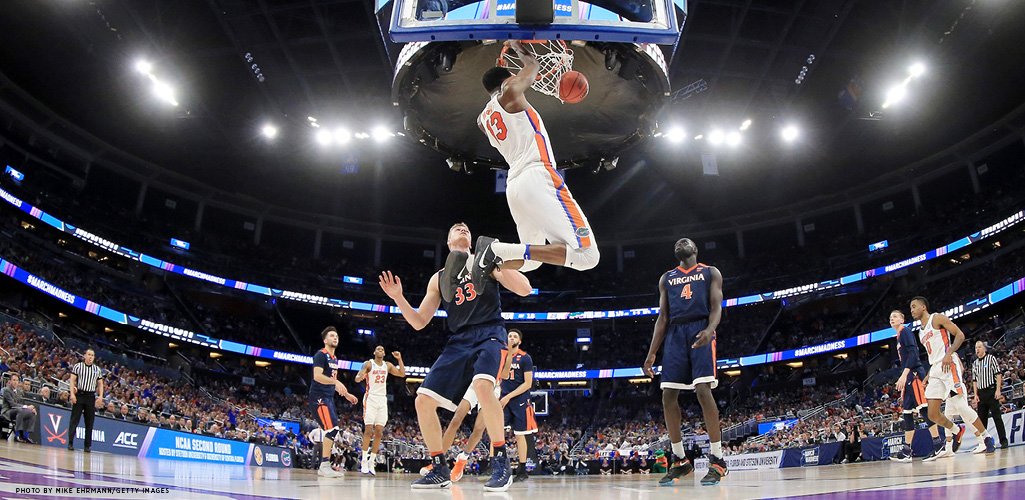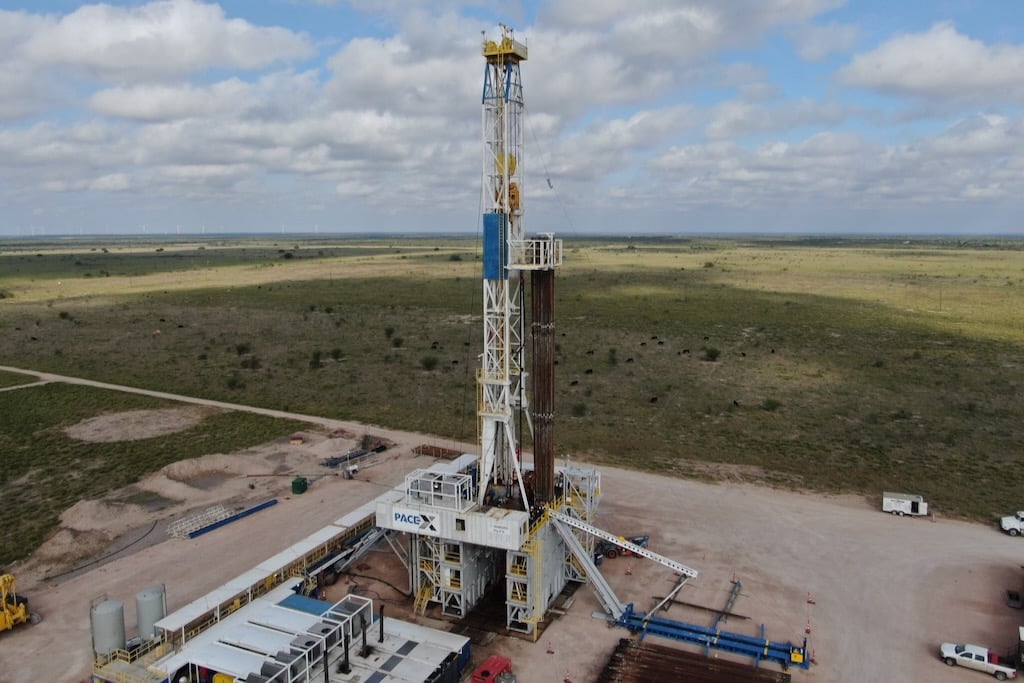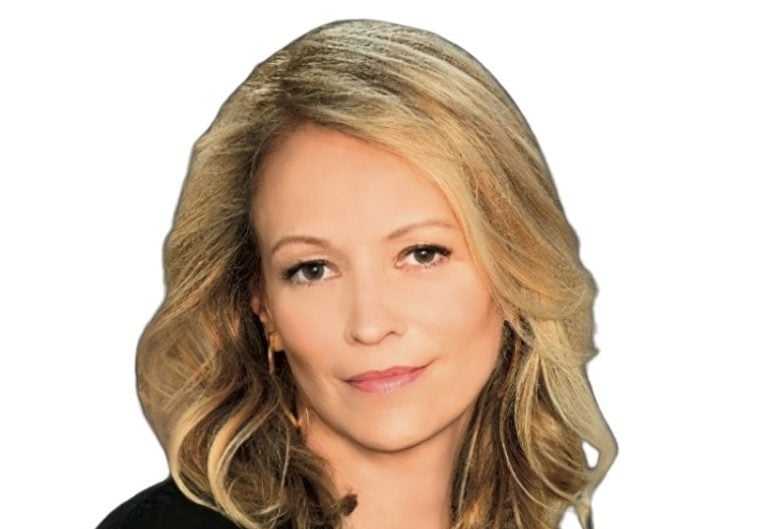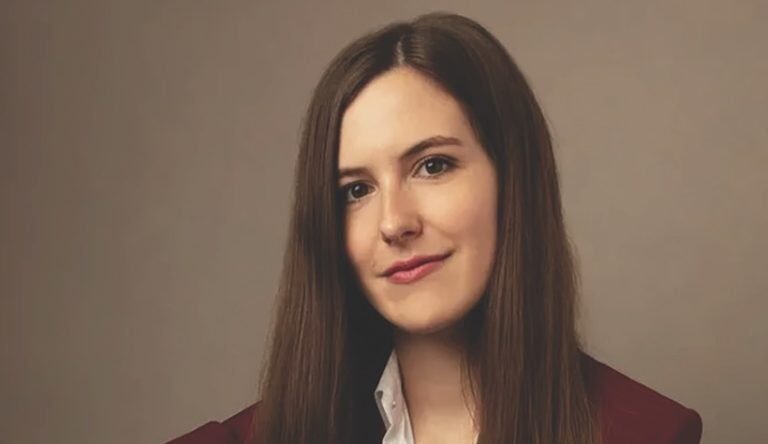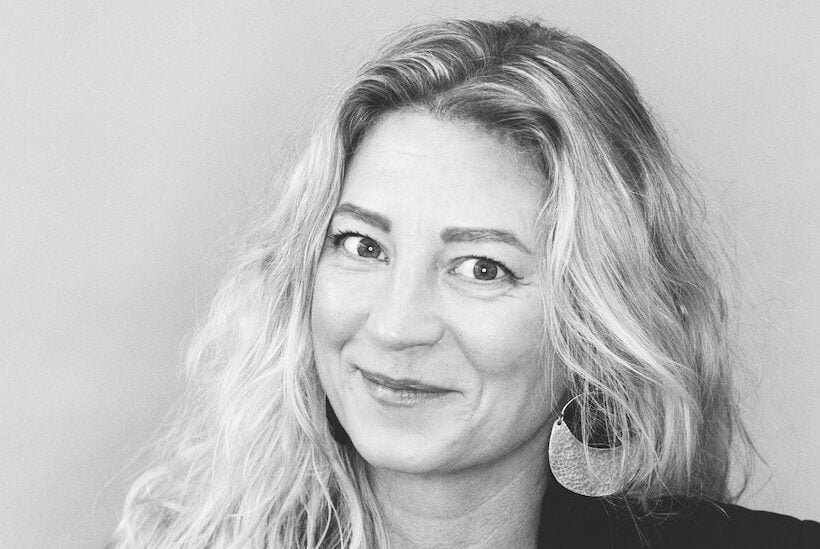If you’re a sports fan, the weekend of March 17 of this year was a fine time to be in Orlando, Fla. The first games of the NCAA basketball tournament, better known as March Madness, were tipping off at the magnificent Amway Center (pictured above) on Church Street in downtown, with matchups featuring local favorites Florida State and the University of Florida. A few blocks away, the city had cordoned off some streets to host a March Madness street party. Further up Church Street, the Orlando City Soccer Club was playing against the Philadelphia Union in OCSC’s brand-new, 25,000-seat, instantly sold-out stadium. Not far away at Bay Hill Club and Lodge, the 51st edition of the Arnold Palmer Invitational PGA golf tournament, one of the golf world’s most prestigious events, was underway. Out at Lake Nona, a 9,000-plus-acre mixed-use development, the University of Central Florida Knights tennis team was matching up with the University of Tulsa at the brand-new United States Tennis Association National Campus, 100 courts strong and probably the best tennis complex in the world. And if none of that was your cup of tea, well, just wait a bit: Two weeks later Camping World Stadium, the site of January’s NFL Pro Bowl, would host WWE’s WrestleMania, gathering 75,000 hard-core fans for a night of artfully choreographed but undeniably athletic mayhem. “I marvel at some of the weekends we’ve had recently,” Orlando mayor Buddy Dyer would tell me, sounding like he couldn’t quite believe it himself.
Let’s get something out of the way early: You probably didn’t expect a magazine article about Orlando to begin with a long paragraph about sports. Not to worry—neither would most folks. When the world thinks of Orlando and its Orange County environs, we think theme parks: Disney, Universal, SeaWorld. That’s why some 66 million tourists came to Orlando in 2015, a new record by about 3 million. (Well—that and the Orange County Convention Center, but they inevitably overlap.)

And there’s nothing wrong with that. The Orlando parks are brilliantly run marvels of technology and customer service that delight their visitors, and they fill the coffers of Orange County governments and businesses with cash. Every city in the world should have such a monkey on its back.
It’s just that Orlando has, in the past 10 or so years, been changing, evolving. The outside world hasn’t much noticed—those theme parks have decades of branding that has permeated the global consciousness—but locals have. “We’re not just a place where people come and ride rides and get back on a plane and go home,” says Rich Crotty, who was mayor of Orange County, which contains Orlando, from 2001 to 2011.
Instead, Orlando has become something of a sports mecca. No, it’s not New York or Boston or Chicago or Los Angeles, with their massive TV markets, century-old teams, tradition-filled NFL franchises and hallowed arenas. With the possible exception of the early ’90s, when Shaquille O’Neal towered over opponents and the Magic were competing for NBA championships, Orlando has no athletic glory days. More recently, though, Orlando has quietly, surprisingly, developed into a city with a vibrant sports economy—not despite the theme parks, but with their active support. “We have become one of the premier sports destinations in the entire country,” argues Dyer. “There’s not an event in the world that we can’t host now.”

How Orlando has merged sports and entertainment to diversify its economy is a story that involves several stubborn-in-a-good-way politicians, some unusually cooperative civic leaders, a number of broad-minded business executives and an unpredictable dose of good luck. Oh, and some beneficial demographic trends. It’s also a story that shows the positive impact that sports can have not just on the economy of a city, but also on its soul.
If there’s a natural place to start this story, it’s probably with Buddy Dyer and his election as mayor in February 2003. Dyer didn’t do it alone by any means, but if you ask Orlandoans who’s most responsible for the growth of the city’s sports business, Dyer is the first name they’ll offer up.
Dyer is a quiet man, and it’s probably fair to say that he’s not a natural politician—he’s of average height and build, he doesn’t feel the need to dominate a room and he thinks more than he talks. But appearances can mislead. Over time, Dyer reveals himself as intense, passionate (quietly passionate) and determined; a man who states his goals and then, in a relentless, no-nonsense kind of way, goes about fulfilling them.
Born in 1958, John Hugh “Buddy” Dyer grew up in nearby Kissimmee, in Osceola County, which was in those pre-Disney days a center of ranching—Dyer’s father drove a cattle truck and rode bulls in rodeos. Dyer left Florida to attend Brown University on a scholarship—he was likely the only student ambling across campus with a cowboy hat and a Southern accent—where he majored in engineering and cocaptained the rugby team. (Again: You would not expect it to look at him.) Dyer next headed home for law school at the University of Florida, where he was editor of the law review. Politics beckoned: In 1992, just five years out of law school, he ran as a Democrat for the Florida state senate and won. After a decade there, he ran for state attorney general, but in November 2002 lost a tight race to Republican Charlie Crist. Dyer was widely thought to be more qualified, but the telegenic Crist, as the Orlando Sentinel put it, benefitted from “political connections, fundraising prowess and slickly produced television advertisements.” Crist took 53 percent of the vote.
Dyer was down, but not out. More or less concurrently, Florida governor Jeb Bush appointed Orlando mayor Glenda Hood to be Florida’s secretary of state, which was fine for most Orlandoans because Hood was ready to leave Orlando, and Orlando was ready to wave goodbye. Dyer pivoted, announced he would run for mayor, and in February beat out several other candidates. His vision: to make Orlando a big, bold, self-confident international city. Dyer, said a columnist for Orlando Weekly, made Orlando residents “see the city he saw, its downtown bursting with energy, packed with skyscrapers and offering residents the amenities of a real metropolis.”
It wasn’t the Orlando that actually existed, particularly in the streets of a downtown that many Americans who’ve been to Orlando didn’t—don’t—even know. Downtown Orlando had come to life in the 19th century as a ranching center, then later became a locus of orange groves, and by the 1950s and ’60s had become a modest but viable small-city downtown. “We had a car dealership, a Sears and a JCPenney’s, a local haberdasher and a local you-name-it,” recalls Crotty. “Downtown was where you went shopping. Then we started building malls…”
“The skyboxes literally hung from the ceiling,” says Crotty, “and the players looked like ants on the floor. It was an obsolete building.”
Those suburban malls slowly sucked the life out of downtown until the late 1970s and early 1980s, when a new nightclub complex called Church Street Station started luring tourists from the still new theme parks, particularly after dark. But Disney and Universal put a cork in that trend when they realized that, if they built enough hotels and planned enough evening festivities—cue Pleasure Island and CityWalk—their visitors would never have to leave the premises. By the time Dyer was elected, downtown Orlando was populated with white-collar workers who’d pull in at 8:45 and out at 5:15. Its retail? Largely “wig shops and tattoo parlors,” says former Orlando mayor Bill Frederick. The Magic had come to town in the late ’80s, but their home, the Orlando Arena, quickly dubbed the “O-rena,” was already in decline. “The skyboxes literally hung from the ceiling,” says Crotty, “and the players looked like ants on the floor. It was an obsolete building.” Adds Magic chief communications officer Joel Glass, “A lot of concerts were bypassing the arena because they heard that it was antiquated. They were passing on Orlando.”
Truth be told, some Orlandoans were OK with that—they either didn’t see a need for change, or didn’t believe that Orlando could change. A relatively common mind-set: Things were good enough. “The town at that time still had a sort of ‘that’s not for us’ mentality,” remembers Steve Hogan, an Orlando resident since 1995 and head of a nonprofit called Florida Citrus Sports. When it came to new projects or events, “the attitude was, ‘That’s cool, but that’s not for us.’ Or, ‘We could never have that, so we shouldn’t try to get that.’” One popular plan to build a performing arts center for concerts and theater had struggled to gain traction. Beyond the theme parks, there just wasn’t a lot happening in Orlando.
Dyer saw the problems and had ambitious solutions: He wanted to diversify the city’s economy and revitalize downtown. I asked him why during a recent interview in Dyer’s downtown office. Why wasn’t the status quo good enough?
Dyer looked at me as if I had suddenly sprouted a second head. “Why would you want to be in public service if you don’t want to improve things?” he said.
He set to work on projects like eradicating the city’s budget deficit (done), implementing an $8.50 per hour minimum wage for city construction workers (done) and working to lift up Parramore, a largely African American neighborhood that had suffered from decades of neglect (progress, but it’s a long-term effort). And he focused on downtown.
Orlando, Dyer knew, was famous for its theme park entertainment. The parks were a blessing, but also a risk. During economic downturns, tourism suffered, and Orlando, which hosts only one Fortune 500 corporate headquarters (Darden Restaurants), also suffered. Sports, a different form of entertainment, could complement the parks while not competing with them; Disney had already shown that with its ESPN Wide World of Sports Complex, which hosts youth teams from around the country. Sports could bring more visitors from more parts of the world while strengthening the connections that Orlandoans felt with their city. And sports downtown would help Orlando attract the young people the city needed for its future; Dyer may have come back after he left, but too many other young men and women just left. What was there to stay for?
It’s worth pointing out that, aside from the Magic, Orlando’s track record with sports teams is—what’s the word?—abysmal. Horrific. Uninspiring. Perhaps the most generous label would be “dogged.” Among the professional sports teams that had taken up residence in Orlando before hanging up their jerseys were the Florida Blazers of the World Football League, the Orlando Renegades of the USFL, the Thunder of the World League of American Football, the Wahoos, the Titans, the Sharks, the Seals, the Jackals and the short-lived Miracle, the Magic’s WNBA sister team that launched in 1999 only to hightail it out of town four years later…for Uncasville, Conn., the home of a Native American reservation with a casino. The Magic were the exception. Their original owners sold to Rick DeVos, cofounder of consumer-to-consumer marketing company Amway, in 1991. But in 1990, the Magic had a record of 31-51—and still sold out 40 of 41 home games.
A pessimist might have noted that Dyer didn’t have a lot of raw material to work with. There was that plan for a performing arts center—not sports, true, but still potentially part of a downtown sports and entertainment district. The Magic were pushing for a new arena and a mayor can’t afford to lose an NBA franchise, but polls showed that a healthy majority of Orlandoans opposed spending public money to build it. “That was one of the most difficult decisions I wrestled with,” recalls Teresa Jacobs, who is now the mayor of Orange County but was then on its board of commissioners. “But if we lost the Magic, that loss would have been an extraordinary devastation.”
Orlando also had the Florida Citrus Bowl, a football stadium built in 1936 and run by the nonprofit Florida Citrus Sports, which hosted college bowl games—including, of course, the Citrus Bowl—and “neutral-site” contests. But that stadium couldn’t win against newer facilities with more comfortable seats, corporate boxes, better food, better everything. “The last neutral-site game was in 2000, Notre Dame and Navy,” says Florida Citrus Sports’ Hogan. “At that point, it was more about survival. ‘Do you really want to lose what’s now been 70 years of equity in the [college] postseason? We’ve got to fix the problem.’”
Working closely with Crotty, Dyer made a strategic bet: He would tackle all three projects—building the performing arts center and a new Magic arena, as well as renovating the Citrus Bowl—at one time. His logic was that of politics: If you focused on one venue at a time, competing interests would get territorial and oppose it. But if you lumped them together, indivisible, then the multiple constituencies would work together. “Everyone was making arguments for different things, but most people, when you got to the end…they knew what each venue brought to the table,” Hogan recalls.
The greatest challenge was money. The estimated cost of Dyer’s venue plan was $1.1 billion, an enormous amount for any city, an unprecedented one for Orlando. And it wasn’t just the amount of money, but the source of it: Dyer and Crotty identified multiple revenue streams—a philanthropic fund for the performing arts center, a hefty contribution from the Magic, others—but about half of the money would have to come from the regional tourist development tax, a 5 percent levy on tourist spending. The theme parks generate the majority of TDT revenue. But those parks aren’t actually in the city of Orlando. They’re in Orange County. So Dyer and Crotty would have to win the support of the Orange County board of commissioners to devote about half a billion dollars that didn’t come from Orlando to building projects in Orlando. “This was not an easy decision,” says Jacobs. “There is a leap of faith that you have to take to move great projects forward.”
“The county was the 800-pound gorilla in the room when it came to funding projects,” explains Crotty. The argument? The venues weren’t city assets but regional ones. Everyone would benefit. “More facilities leads to more visitors, which leads to more heads in beds,” Crotty says, using the language of tourist-based economies the world over.
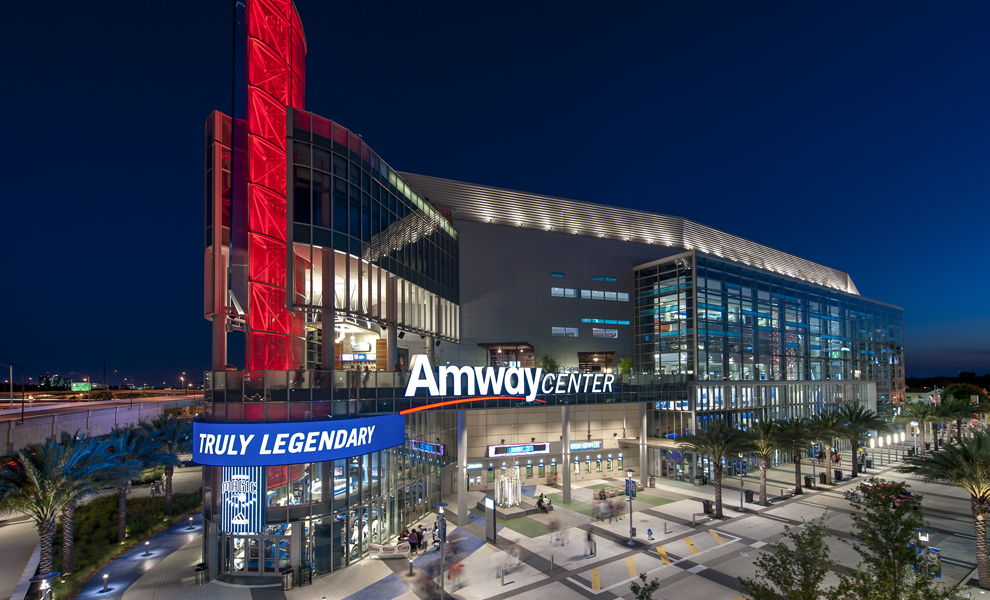
Dyer did his best to soften the economic blow. The mayor and the Magic agreed, for example, that Orlando would own and operate the proposed Amway Center, which would make it the only city to own its NBA arena. The reason? There are only 41 NBA home games every season, and Dyer wanted to keep the building busy the rest of the time. He also thought it was important to bond the community and the arena. “Beyond the Magic,” he explains, “we were selling it as a community venue.” To help a rising tide lift all boats, Dyer and his team created The Blueprint, a program to train the homeless, ex-cons and residents of Parramore to work construction on the venues. And they required that a quarter of the contracts go to women- and minority-owned firms.
They got buy-in from the parks, Disney and Universal in particular. In 2006, the Orange County board voted to raise the TDT from five cents on the dollar to six. Crotty cut a deal with Disney and Universal: For one year, half of the money raised from that new penny would go to an ad campaign to drive traffic to the parks. The other half would go to the venue package. “The parks were on board, but they wanted a piece of the pie in the first year,” Crotty says. “Once I agreed to that, everything else was done.”
On July 26, 2007, the Orange County board voted 5–2 to pass Dyer’s venue plan. Ten years later, in offices all around Orlando, you can still see framed copies of the next day’s Orlando Sentinel, featuring a big picture of Dyer and Crotty looking jubilant and the all-caps headline, “VISION FULFILLED.”
There were challenges ahead, but the biggest hurdle was cleared. In 2010, the new Amway Center opened, a state-of-the-art basketball arena a few blocks from the mayor’s office. The Magic haven’t been good, but attendance is strong, and the city has also used Amway to host Easter services, back-to-school events and fundraisers. “We’ve done a lot of things that couldn’t bear the freight if you had to pay the full cost of the venue,” Dyer says.
In January 2014, renovation of the Citrus Bowl, down the street from the Amway Center, began; it was finished on time and on budget in November 2014. Back in business and rechristened Camping World Stadium in honor of a new sponsor, it began hosting events that wouldn’t previously have considered the stadium: a Miami Dolphins preseason game in 2016, the NFL Pro Bowl this year, WrestleMania, concerts by bands like the Rolling Stones and Metallica. A reenergized Florida Citrus Sports and its offshoot, Lift Orlando, used the new energy (and money) to advance their mission of social progress in the surrounding West Lakes communities, investing in a $40 million mixed-income housing project, promoting health and wellness, opening schools and bringing local kids to the games free if they got good grades.
“Yes, we’re going to have huge, nationally televised events,” says Harold Mills, chairman of Florida Citrus Sports and a board member of Lift Orlando. “But the win should be, what if maybe for the first time ever a community that’s largely been left out of the conversation of success gets healthy by what happens here? Wouldn’t that be the cool story?”
Also in November 2014 the Dr. Phillips Center for the Performing Arts—named for the late Orlando orange juice magnate and philanthropist—opened to rave reviews. A piece of architecture that any city would appreciate, it included the 2,700-seat Walt Disney Theater for Broadway-type events and a 300-seat theater for smaller shows. In 2015, the New York Times pointed to the Dr. Phillips Center as a new reason to visit Orlando, noting that “the city is growing up.” A second phase of the project, a 1,700-seat concert hall, broke ground this spring.
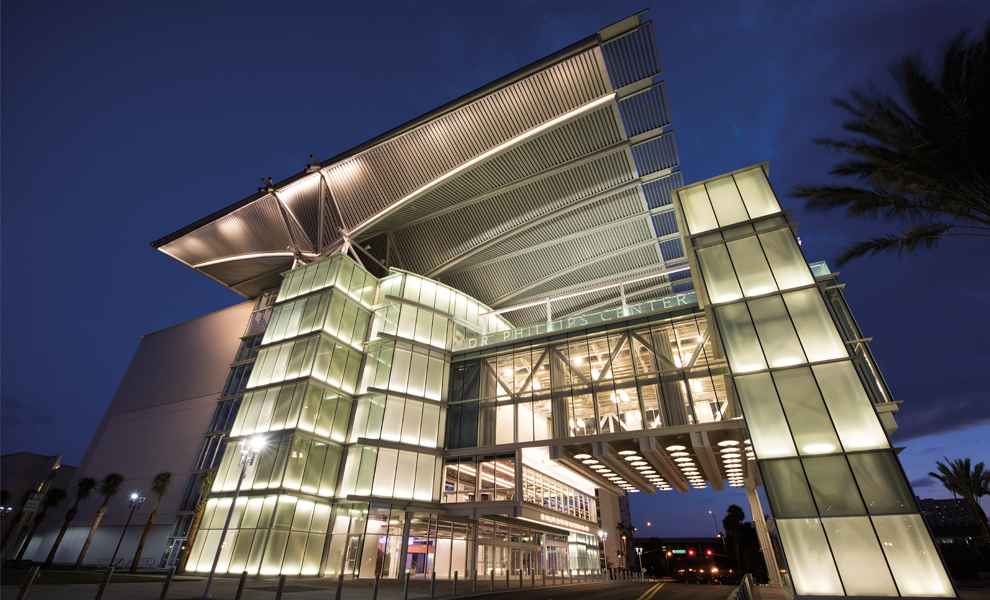
By 2010 the foundation of Dyer’s vision was in place, and Orlando voters would reward him with increasingly strong reelection victories. At about the same time, Dyer’s plan to transform Orlando into a sports hub got an additional boost from an unexpected source: a soccer-loving British entrepreneur named Phil Rawlins.
Rawlins, 58, had founded a tech sales and marketing company called the Sales Consultancy. He brought it to the U.S., grew the business, merged it with another company, helped sell it, then left in 2001 to pursue his childhood passion, soccer. He bought a 10 percent stake in the English soccer team Stoke City FC for £1.5 million and then decided to start a minor league team, the Aztex, in his new hometown, Austin, Texas. Rawlins is by all accounts a brilliant marketer, but the Aztex never really clicked in Austin; as Rawlins says now, their arena wasn’t great, they couldn’t sell beer at games, they had no suites for corporate sponsors and they were competing with the dominant brand in Austin sports, the University of Texas.
So in 2010, Rawlins says, “we reached out to Major League Soccer and said, ‘We’re willing to relocate the franchise, but we really need to get it right this time and get to a marketplace with potential [to become] MLS. Guide us to where we should look.’ And they said, ‘We have no coverage in the Southeast.’” So Rawlins did due diligence on cities like Atlanta, Charleston, S.C., Birmingham, Ala., Jacksonville, Fla., and Orlando. “And the more we looked at Orlando, the more it started to rise to the top of the list.” In the city’s favor, Rawlins says, were the facts that it’s a big television market and a growing city whose average age is 34—perfect for soccer’s millennial demographic.
In late 2010, Rawlins moved the team, now renamed the Orlando City Soccer Club and soon decked out in purple uniforms with a lion logo, to Orlando. The Lions, as they were known, played in the Citrus Bowl until renovation began, then at Disney’s ESPN Wide World of Sports Complex. Attendance grew from an initial 6,000 to around 9,000 per game—outstanding for a minor league team. From his experience with Stoke City, Rawlins knew that soccer fans want to feel deeply connected to their teams. “So we would go out and meet with the fans—we knew the fans,” he says. “I was never afraid to go out to a tailgate, have a beer with them, sit in the stands with them.”
In 2012 Rawlins went back to MLS officials and said, “We’re ready—are you?” They responded with a list of four criteria: To gain MLS status, Rawlins had to prove that the marketplace was strong, that the team had substantial corporate support, that they had an ownership group with very deep pockets and that they had a plan to build a soccer-specific stadium downtown—again, to attract the young fans living and working in the city.
The first two elements were already there. To find the truly deep pockets, Rawlins brought in Flávio Augusto da Silva, a Brazilian who lived in Orlando but had made a fortune opening a chain of language schools in his native country. Impressed by the sport’s growth and youthful demographics, da Silva had been looking for an opportunity to invest in U.S. soccer, and he would become a 70 percent owner. “Baseball,” he says now, “has a fan base whose average age is 50. Soccer is 24.” Without even really trying, Orlando had become home to a well-funded team, inspired by a passionate and energetic backer, just as the sport was beginning to explode in the U.S.
In April 2013, Orlando bought land in between Camping World and the Amway Center on which to build a soccer stadium. In November of that year, MLS announced that OCSC would be joining the league. Orlando City played its first MLS game at the Citrus Bowl in March 2015 against New York City FC; an astonishing 62,000 fans attended. That year, Orlando City also announced the formation of a women’s team, the Orlando Pride, one of 10 National Women’s Soccer League teams.
Construction of Orlando City Stadium, which ultimately cost about $150 million, commenced in August 2015. Funding was entirely private, a decision da Silva made after state aid got bogged down in the legislature. “We brought in investors and didn’t use any public money,” he says. “It was a very serious commitment. It’s not like staying for a little while—it’s like a marriage. It’s long term.”
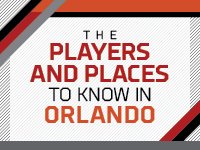
The stadium opened this spring, and it was widely hailed as an architectural and popular triumph. Seating about 25,500, it features natural grass, a sunken field to amplify crowd noise and a “safe-standing” area for the hardest-core fans, who stand for the entire game, fueled only by their passion for the team—and the contents of their cups in the holders that line the section. Some 18,000 season tickets have already been sold, and there’s a waiting list of several thousand for future ones. This year, Orlando City Stadium will also host the 2017 NWSL Championship.
There’s no question that OCSC has caught on in Orlando in a way that no one expected—they could be the most popular team in the city, and their fans are almost certainly Orlando’s most intense. “It may be the most exciting thing, sports-wise, that’s happened here,” says Crotty. “You have to see these fans to believe them,” Mayor Jacobs says. “They can make anybody young again.”
More quietly, under the leadership of VP of community relations Kay Rawlins (Phil’s wife until they recently separated), Orlando City has been engaging with the Parramore community. The team’s Orlando City Foundation built six “mini-pitches” for local kids and are working to fight childhood obesity in various ways including the planting of community gardens. Once a year, they bring local kids onto the field, 100 children between the ages of 8 and 10, to play 50 at a time versus OCSC’s starting lineup. It’s quite a scene. “The players are laughing so hard,” Rawlins says. “Everywhere they go, they’ve got 40 kids around their ankles.”
And Orlando City has been socially engaged in other ways. When same-sex marriage became legal in Florida in 2015, Kay Rawlins recalls, the team changed its Facebook profile picture to a rainbow flag in solidarity. “We did have some fans who came on [the page] and said, ‘I can’t support this club anymore,’” she says. But the rest responded by saying, “We don’t need you as fans—don’t let the door hit you on the way out.”
That connection between the team and its fans would manifest itself most powerfully after the June 12, 2016, massacre at Pulse, a gay nightclub. OCSC’s next game was on the 18th, and on their own, organizing on social media, their fans created a deeply moving tribute. Section by section at Camping World Stadium, as per their social media plan, OCSC fans wore shirts matching the colors of that rainbow flag, perfectly coordinated and completely united.
It’s not that Orlando is done, finished, voilà. Yes, it’s got beautiful new buildings, WrestleMania, the Arnold Palmer Invitational, the Magic, OCSC. And it has a growing infrastructure of educational institutions and businesses that support the sports economy—places like Full Sail University, the Golf Channel and gaming company Electronic Arts. And it’s got great synergies with the theme parks, some of the most powerful brands in the world.
But skeptics point out that the city still lacks major league baseball and, most glaringly, the NFL. With three other NFL teams in Florida—the Dolphins, the Tampa Bay Buccaneers and the Jacksonville Jaguars—it’s unlikely to get one anytime soon. Nonetheless, folks in Orlando will tell you that, heck yeah, they’d love a pro football team.
But in some ways, the hardest work is done. Dyer has succeeded in commencing the transformation of a downtown and diversifying the economy of his city. He’s changing the way the outside world sees Orlando, and perhaps most important to him, he’s changed the way Orlando sees itself.
Fourteen years ago, when Dyer was first elected and kept talking about sports and downtown, “a lot of people couldn’t see the vision,” he recalls now. “But you look at the things we’ve done….We have created an environment where everything we do can be world-class.”
Read the interview with Katrina Adams, the USTA’s first African American CEO, about how expanding opportunities for tennis. Full Sail University

